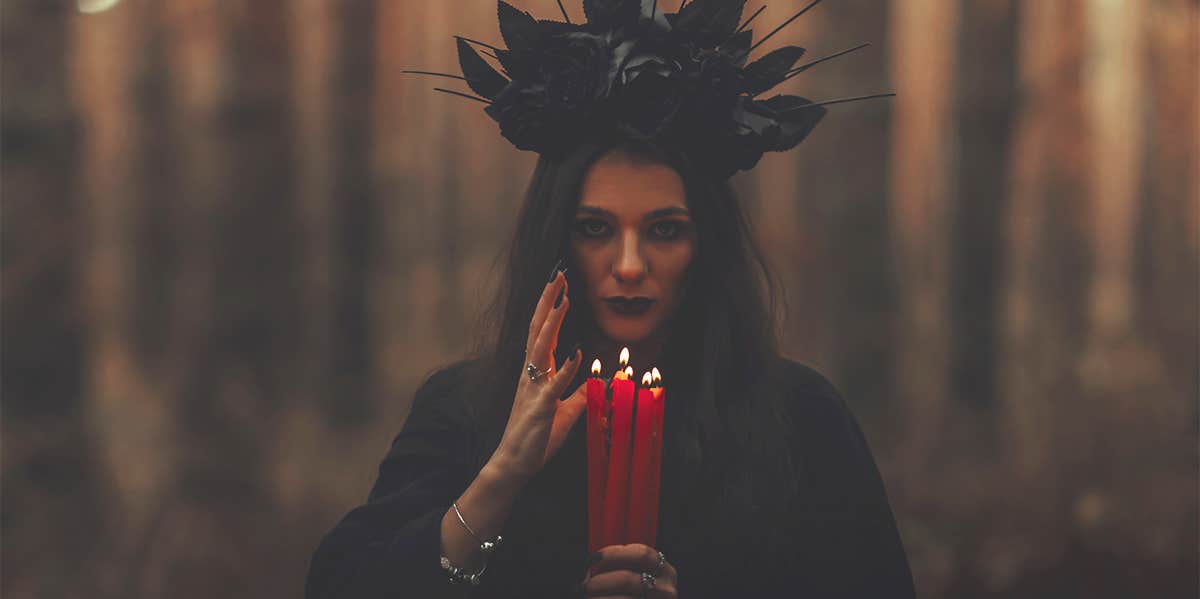What Is A Bruja Or Brujo In Witchcraft? Brujería Meaning Explained
The practice has been around for centuries.
 alexkoral / Shutterstock
alexkoral / Shutterstock The term brujería has been used in many ways and depicted in different cultures over the years.
A Spanish term, brujería formally means witchcraft and is used to "describe or disparage occult religious practices in some Latin American and Afro-Caribbean cultures with indigenous roots."
The more colloquial and modern brujería meaning, according to Urban Dictionary, is witchcraft that causes a person to experience a string of bad luck.
Brujería dates back to the early 15th century before indigenous communities were colonized by the Spaniards.
Prior to being colonized, women were the predominant practitioners of brujería and were typically regarded as healers and midwives.
In the 16th century, women of all social levels lost most of their legal autonomy after marriage while their husbands retained the right to beat their wives or have illicit affairs.
So, rather than counting on a judiciary and religious system that would only let them down, women turned to sexual magic and witchcraft to combat omnipresent patriarchal domination.
Since Latin America was colonized by Europeans in the 15th century, some Native healing medicine and magical traditions combined with the Roman Catholic Church led to hybridity in contemporary spirituality.
Because brujería was not based upon Christian ideologies, as it didn’t worship a Christian God or comply with the Catholic Church’s religious roles and functions, the practice immediately created a clash between Old World and New World beliefs.
Spaniards didn’t understand the brujería practice and the cultural influence, especially when it came to the women who undertook leadership roles within the Afro and Indigenous cultures.
They saw brujería as superstitious and primitive.
Brujería became a taboo practice that warranted prosecution and, for those considered full-blown witches, execution.
As a result of colonization, Indigenous communities were forced to convert to Catholicism, meaning their own religion of brujería was invalidated. In the 15th and 16th centuries, the Catholic Church identified brujas/brujos as witches.
São Paulo-based Wiccan Priestess Marília de Abreu details how witchcraft came to São Paulo by way of its Indigenous peoples, European immigrants, enslaved Africans, as well as through Cuban Santería, among other traditions, as a form of resistance and self-identity.
“The colonizers found Indigenous magic here and later with slavery, African magic," Abreu explained in an interview. "The natives were aware of native medicinal herbs for diseases that the colonizer had no medicine for. For the Black people who came as slaves, their magic was also a form of resistance and a way of maintaining their ancestral cultural roots.”
Many of the rituals in brujería are based on the procedures, practices and attitudes passed down by its participants, and heavily depend on forces of nature and the spontaneity of the spirits.
The practice of brujería has been passed down from generation to generation despite the racism, oppression, and isolation of the spiritual practices.
The modern practice of brujería is, in its essence, magic that is a blend of folklore, herbalism, African magic and healing, and Catholicism.
It involves charms, divination, love spells, and hexes cast by brujas (female), brujos (male), or brujix (genderqueer).
Today, many Latinx people are embracing their brujería identity, wanting to spread the love of their culture and history.
The modern brujería movement involves practices like cleansing, ancestor worship, lighting candles, and honoring the earth. And in some cases, ceremonies entail wearing all-white, singing, and preparing sacred offerings.
Many brujas have taken to social media to reclaim their power.
“We’re reclaiming our power; for far too long have we practiced in secrecy due to fear/society,” said Emilia Ortiz, a well-known practitioner of the craft through her Instagram account. “Now, though? It’s our time. The same way other women/femmes are reclaiming their power in other areas — this is no different.”
In 2016, Afro-Puerto Rican rapper Princess Nokia released a song called “Brujas,” acknowledging her connection to her ancestors and the spiritual practice.
Mexican-born playwright and television writer Tanya Saracho announced in January 2018 that she’s developing a television show named "Brujas" that is centered around the Bruja movement in Chicago and follows four Afro-Latinas, though in 2020 Saracho noted that development is currently paused.
Today, much of what was once misunderstood about brujería is being corrected by people of color who are allowing others to relearn the cultural importance of the practice.
Brujería today is about reclaiming power and freedom, changing the dialogue, and creating more spaces for Latinx people to celebrate their symbols of power.
There is always a way to protect yourself from brujería with a method called shielding, which is all about creating a barrier to protect yourself from negative energy. An energy barrier is like a second skin, and it can keep you safe from any magical influences or threats that you might encounter in your life.
To begin shielding, you must spend time sensing your own energy and moving it in one direction then another, focusing on what it feels like as well as what you are seeing.
Once you have become acquainted with your energy, begin pushing it to expand around your body. This is the part where you visualize it as a second skin.
Maintain this solid energy skin and push against outside forces whenever you feel the need. It takes time and practice to perfect the act of shielding, but offers a high reward in the end.
Nia Tipton is a writer living in Brooklyn. She covers pop culture, social justice issues, and trending topics. Keep up with her on Instagram and Twitter.
